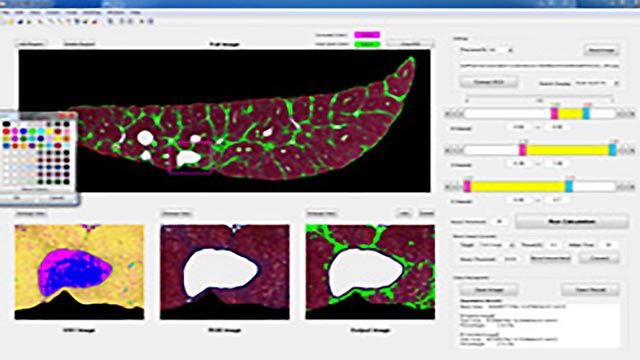Mitsubishi Tanabe Pharma Develops Data Analysis Tools to Speed Drug Discovery
“The algorithms we developed in MATLAB and deployed as applications with help from MathWorks consultants have enabled us to obtain quantitative analysis results, avoid human error, collaborate more effectively, reproduce results reliably, and double the number of feasibility studies completed yearly.”
Challenge
Solution
Results
- Algorithms developed four times faster
- Simultaneous analysis of multiple drugs enabled, with analysis times cut by 75%
- Deployment workload reduced by 83%

For pharmaceutical companies, animal-based biological studies, including drug metabolism and pharmacokinetics (DMPK), pharmacological, and toxicological studies, provide some stepwise checkpoints before promising lead compounds proceed to clinical testing in humans and ultimately regulatory submission. However, a gap often exists between the data scientists who develop biological data analysis tools and the bench-level biologists and chemists who use them to improve R&D productivity in drug discovery.
Mitsubishi Tanabe Pharma worked with MathWorks Consulting Services to bridge this gap and make drug candidate selection more efficient. The company developed MATLAB® based biological data analysis tools that shorten iterations in developing analytical algorithms, increase the biologists’ efficiency, enable them to evaluate more drug candidates, and accelerate the discovery process.
“Using tools we developed in MATLAB, our biologists can obtain quantitative results automatically, reliably reproduce and manage results, and compare the effects of multiple drugs,” says Ryuta Saito, research scientist on bioinformatics at Mitsubishi Tanabe Pharma. “As a result we can screen more drug candidates, perform retrospective analysis of previously abandoned samples, and double the number of feasibility studies we complete annually.”
Challenge
Mitsubishi Tanabe Pharma sought to improve drug candidate selection by making the entire biological data analysis process more accurate, more repeatable, and faster. Typically at Mitsubishi Tanabe Pharma, after data is acquired in a laboratory animal study it is analyzed in a two-step process.
In the first step, data scientists with experience writing code develop image processing and data processing algorithms for a subset of the data. The data scientists used to write algorithms in Java®, Perl, R, and Python, but this process had several drawbacks. First, it was time-consuming because scientists often wrote code from scratch even for well-known image processing techniques. Second, they had difficulty reading data from files in various formats. Third, biologists often found the algorithms difficult to use, and numerous iterations were needed to refine and deploy easier-to-use versions.
In the second step, bench biologists use the algorithms to analyze and evaluate their original data set. In the past, bench biologists’ workloads included manual tasks such as copying results into spreadsheets, managing folders, creating files for specific image groups, and identifying analytic regions in high volumes of image files. Analysis results were not always reproducible.
The company sought to make both steps in this process more efficient.
Solution
Mitsubishi Tanabe Pharma developed biological data analysis algorithms using MATLAB, Image Processing Toolbox™, Bioinformatics Toolbox™, and Statistics and Machine Learning Toolbox™, and worked with MathWorks consultants to use MATLAB Compiler™ to deploy the algorithms as applications.
Working in MATLAB and the toolboxes, data scientists developed algorithms for image segmentation, object tracking in video, and data matching. These algorithms invoked functions in the toolboxes to read and preprocess image, video, and genomic data from standard file formats, and perform curve smoothing, noise reduction, peak detection, morphological operations, image quantification, and other operations.
The team optimized the algorithms by testing them with sample data and various parameters.
After refining and testing their algorithms, the data scientist team worked with MathWorks consultants to incorporate the algorithms in a suite of graphical applications that the bench scientists could use for diagnosis of disease in internal organs, behavioral pattern analysis, and gene expression analysis.
Using MATLAB Compiler, the team created standalone executable versions of these applications that could be used by biologists, even those not running MATLAB.
Bench biologists use these applications to evaluate a sample subset of images and data with various parameter values and algorithm options. After identifying the best combination and options, they use the applications to analyze the complete data set.
Using the MATLAB based tools and applications codeveloped with MathWorks Consulting Services, Mitsubishi Tanabe Pharma biologists have already identified at least one promising drug candidate.
Results
- Algorithms developed four times faster. “Algorithms that took months to implement in C/C++ or Java can be developed in MATLAB in weeks or sometimes days,” says Saito. “With its built-in functions, interactive environment, and ability to integrate multiple data formats, MATLAB enabled a fourfold increase in development speed.”
- Simultaneous analysis of multiple drugs enabled, with analysis times cut by 75%. “With interactive analysis tools built with MATLAB and help from MathWorks consultants, our biologists can complete sample analysis that formerly took 12 hours in just 2.5 hours,” says Saito. “Now, we can evaluate the effects of multiple drugs and compare them at the same time.”
- Deployment workload reduced by 83%. “MathWorks consultants developed the applications that our biologists use based on the algorithms that we created in MATLAB, reducing our full-time equivalent (FTE) workload by 83%,” notes Saito. “The consultants worked closely with our data scientists and biologists to understand our requirements, and completed the project much faster than we could have ourselves.”